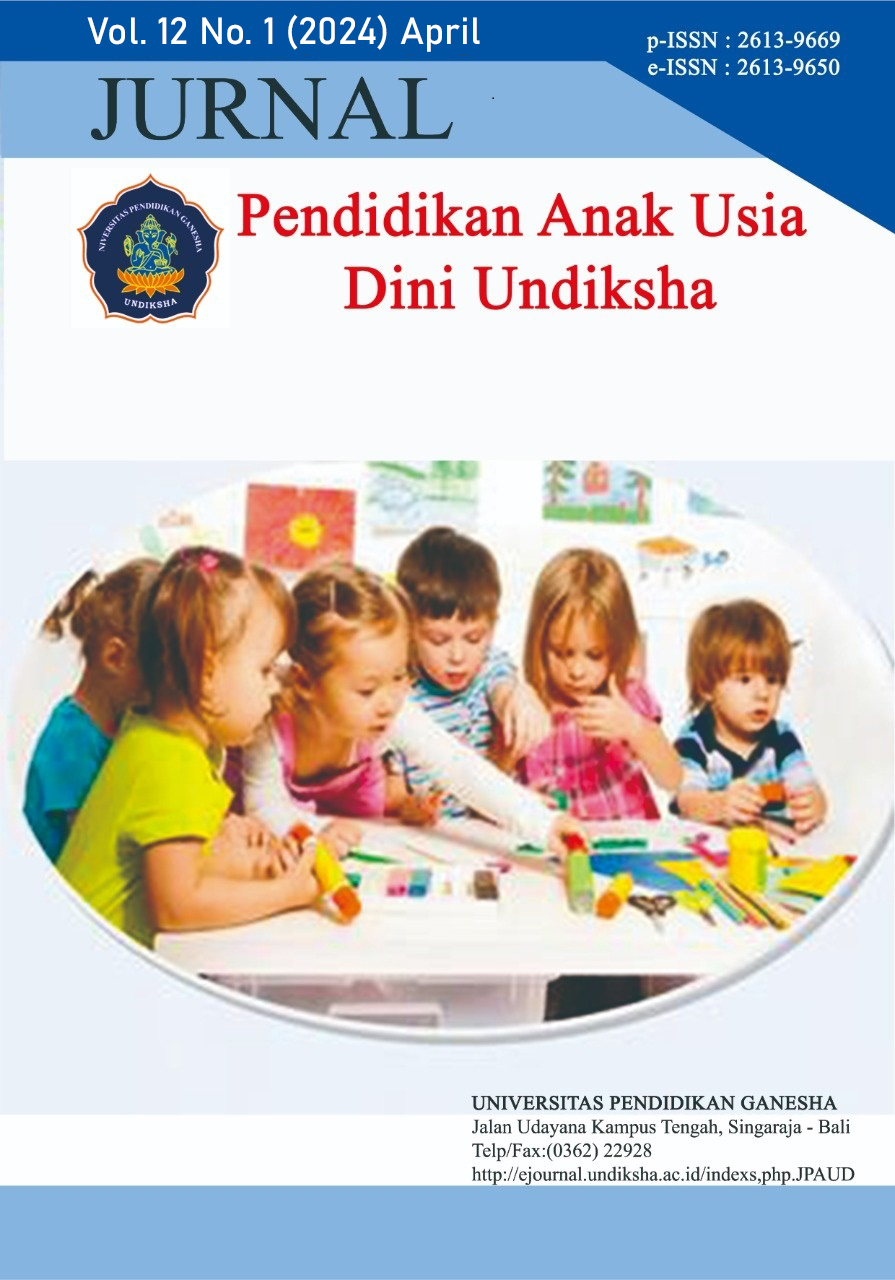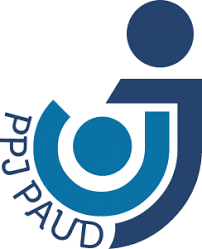Pictorial Number Sandpaper Media in Recognizing Number Symbols and Training Children's Fine Motor Skills
DOI:
https://doi.org/10.23887/paud.v12i1.73543Keywords:
Number Symbols, Fine Motor Skills, Pictorial Number Sandpaper MediaAbstract
There are still many children whose development is not optimal, especially in sensory, fine motor, and cognitive development in understanding number symbols. Therefore this study aims to analyze the effectiveness of pictorial number sandpaper media in developing students' sensory, motor, and cognitive abilities in recognizing number symbols 1-10. The method used in this research is mixed method, which combines quantitative and qualitative methods with a sequential approach. The subjects in this study were 20 kindergartens level-A students at Islamic School. Data collection techniques in this study through observation and documentation. The data analysis technique used is the descriptive-analytic technique, which analyzes the variables consisting of cognitive improvement, and fine motor skills through pictorial number sandpapper games. The results showed an increase in fine motor skills and understanding of number symbols. The results of quantitative analysis show an effective increase in the recognition of number symbols from 25% to 100%, which means that children can recognize number symbols well. Likewise, for the results of observational data in training fine motor skills, students experience effective development in fine motor skills, namely, students can improve concentration and focus, improve coordination between hands and eyes, improve visual design skills, improve the ability to control hand and finger movements.
References
Agustina, S., Nasirun, M., & Delrefi, D. (2018). Meningkatkan Keterampilan Motorik Halus Anak Melalui Bermain Dengan Barang Bekas. Jurnal Ilmiah Potensia, 3(1), 24–33. https://doi.org/10.33369/jip.3.1.24-33. DOI: https://doi.org/10.33369/jip.3.1.24-33
Alamsyah, M. R., Vahira, A. D., Fadhilah, S. H., & Paputungan, M. (2022). Penyuluhan Meningkatkan Sensorik dan Motorik Anak-anak di Yayasan TPQ (Taman Pendidikan Qur’an) Alansari Melalui Media Nonton Bareng Dan Lomba Kelurahan Rempoa. Seminar Nasional Pengabdian Masyarakat LPPM UMJ, 1–5. http://jurnal.umj.ac.id/index.php/semnaskat.
Alenezi, A. (2020). The role of e-learning materials in enhancing teaching and learning behaviors. International Journal of Information and Education Technology, 10(1), 48–56. https://doi.org/10.18178/ijiet.2020.10.1.1338. DOI: https://doi.org/10.18178/ijiet.2020.10.1.1338
Ameilia, R., Elan, & Mulyadi, S. (2020). Melalui Permainan Kartu Angka Sebagai Alat Untuk Mengenalkan Konsep Lambang Bilangan Semi Konkret 1 Sampai 10 Pada Anak Usia 4 Sampai 5 Tahun Penelitian Quasi Experiment. Jurnal Pendidikan Guru, 1(4), 179–190. https://doi.org/10.32832/jpg.v1i4.3554. DOI: https://doi.org/10.32832/jpg.v1i4.3554
Bayley, S. H. (2022). Learning for adaptation and 21st-century skills: Evidence of pupils’ flexibility in Rwandan primary schools. International Journal of Educational Development, 93(March 2021), 102642. https://doi.org/10.1016/j.ijedudev.2022.102642. DOI: https://doi.org/10.1016/j.ijedudev.2022.102642
Cahyani, N. A. D. (2020). Meningkatkan Kemampuan Mengenal Lambang Bilangan Pada Anak Usia 4-5 Tahun Melalui Permainan Balok Angka. Jurnal Pendidikan Anak Usia Dini Undiksha, 8(3), 170–179. https://doi.org/https://ejournal.undiksha.ac.id/index.php/JJPAUD. DOI: https://doi.org/10.23887/paud.v8i3.25070
Chafiyah. (2021). Bermain dengan Menggunakan Media Toples Pintar (TOPPIN) untuk Meningkatkan Kemampuan Kognitif Anak di TK Masyithoh 04 Kergon Kota Pekalongan. Action Research Journal, 1(No. 2 Desember), 180–183. https://doi.org/10.51651/arj.v1i2.137. DOI: https://doi.org/10.51651/arj.v1i1.65
Chasanah, N., Widodo, W., & Suprapto, N. (2022). Pengembangan Instrumen Asesmen Literasi Sains Untuk Mendeskripsikan Profil Peserta Didik. PENDIPA Journal of Science Education, 6(2), 474–483. https://doi.org/10.33369/pendipa.6.2.474-483. DOI: https://doi.org/10.33369/pendipa.6.2.474-483
Cox, A. M. (2019). Learning bodies: Sensory experience in the information commons. Library & Information Science Research, 41(1), 58–66. https://doi.org/https://doi.org/10.1016/j.lisr.2019.02.002. DOI: https://doi.org/10.1016/j.lisr.2019.02.002
Craik, F. I. M., & Rose, N. S. (2012). Memory encoding and aging: A neurocognitive perspective. Neuroscience and Biobehavioral Reviews, 36(7), 1729–1739. https://doi.org/10.1016/j.neubiorev.2011.11.007. DOI: https://doi.org/10.1016/j.neubiorev.2011.11.007
Creswell, J. W. (2013). Qualitative, Quantitative, and Mixed Methods Approaches: 4th edition. In Organizational Research Methods (Vol. 6, Issue 3). https://doi.org/10.1007/s13398-014-0173-7.2.
Dinehart, L. H. (2015). Handwriting in early childhood education: Current research and future implications. Journal of Early Childhood Literacy, 15(1), 97–118. https://doi.org/10.1177/1468798414522825. DOI: https://doi.org/10.1177/1468798414522825
Edirisinghe, C., Podari, N., & Cheok, A. D. (2018). A multi-sensory interactive reading experience for visually impaired children; a user evaluation. Personal and Ubiquitous Computing, 26, 807–819. https://doi.org/10.1007/s00779-018-1127-4. DOI: https://doi.org/10.1007/s00779-018-1127-4
Erbil, D. G. (2020). A Review of Flipped Classroom and Cooperative Learning Method Within the Context of Vygotsky Theory. Frontiers in Psychology, 11(June), 1–9. https://doi.org/10.3389/fpsyg.2020.01157. DOI: https://doi.org/10.3389/fpsyg.2020.01157
Fatimah, A. S., & Santiana, S. (2017). Teaching in 21St Century: Students-Teachers’ Perceptions of Technology Use in the Classroom. Script Journal: Journal of Linguistic and English Teaching, 2(2), 125. https://doi.org/10.24903/sj.v2i2.132. DOI: https://doi.org/10.24903/sj.v2i2.132
Fitriani, F., & Maemonah, M. (2022). Perkembangan Teori Vygotsky Dan Implikasi Dalam Pembelajaran Matematika Di Mis Rajadesa Ciamis. Primary: Jurnal Pendidikan Guru Sekolah Dasar, 11(1), 35–41. https://doi.org/10.33578/jpfkip.v11i1.8398. DOI: https://doi.org/10.33578/jpfkip.v11i1.8398
Fitriyani, F., Sumantri, M. S., & Supena, A. (2019). Language development and social emotions in children with speech delay: case study of 9 year olds in elementary school. Jurnal Konseling Dan Pendidikan, 7(1), 23. https://doi.org/10.29210/130600. DOI: https://doi.org/10.29210/130600
Fransiska, G., & Khotimah, N. (2023). Pengaruh Media Kartu Angka Terhadap Kemampuan Mengenal Lambang Bilangan 1-10 Kelompok A Di Tk Katolik Santa Theresia Kalijudan Surabaya. Lentera: Journal of Gender and Children Studies, 3(1), 12–25. https://doi.org/https://journal.unesa.ac.id/index.php/JOFC.
Gouet, C., Carvajal, S., Halberda, J., & Peña, M. (2020). Training nonsymbolic proportional reasoning in children and its effects on their symbolic math abilities. Cognition, 197(December 2019), 104154. https://doi.org/10.1016/j.cognition.2019.104154. DOI: https://doi.org/10.1016/j.cognition.2019.104154
Hakim, S. N., Sopha, M., Febriana, S., Rachmat, M., & Dewi, I. P. (2022). Peningkatan Kemampuan Motorik Halus Anak Usia 5-6 Tahun dengan Teknik Meremas. Aksara: Jurnal Ilmu Pendidikan Nonformal, 8(3). https://doi.org/10.37905/aksara.8.3.1957-1966.2022. DOI: https://doi.org/10.37905/aksara.8.3.1957-1966.2022
Hite, R. L., Jones, M. G., Childers, G. M., Ennes, M., Chesnutt, K., Pereyra, M., & Cayton, E. (2019). Investigating Potential Relationships Between Adolescents’ Cognitive Development and Perceptions of Presence in 3-D, Haptic-Enabled, Virtual Reality Science Instruction. Journal of Science Education and Technology, 28(3), 265–284. https://doi.org/10.1007/s10956-018-9764-y. DOI: https://doi.org/10.1007/s10956-018-9764-y
Irawati, L. (2023). Artikel Implementasi Pembelajaran Practical life dan Sensorial untuk Pengembangan Kemampuan Motorik Halus Anak Usia Dini di Omah Uthie Daycare Cibinong (Vol. 6, Issue 11, pp. 8514–8520). https://doi.org/http://Jiip.stkipyapisdompu.ac.id. DOI: https://doi.org/10.54371/jiip.v6i11.2647
Iswahyuni, V., Yusuf Muslihin, H., & Rahman, T. (2023). Perkembangan Motorik Halus Anak Usia 2-3 Tahun Melalui Permainan Sensori di Daycare. Jurnal PAUD AGAPEDIA, 7(1), 17–24. https://ejournal.upi.edu/index.php/agapedia.
Juwantara, R. A. (2019). Analisis Teori Perkembangan Kognitif Piaget Pada Tahap Anak Usia Operasional Konkret 7-12 Tahun Dalam Pembelajaran Matematika. Al-Adzka: Jurnal Ilmiah Pendidikan Guru Madrasah Ibtidaiyah, 9(1), 27–34. https://core.ac.uk/download/pdf/327227393.pdf. DOI: https://doi.org/10.18592/aladzkapgmi.v9i1.3011
Kamtini, K., & Sitompul, F. A. (2019). Pengaruh Metode Bernyanyi terhadap Kemampuan Mengingat Huruf dan Angka pada Anak Usia Dini. Jurnal Obsesi : Jurnal Pendidikan Anak Usia Dini, 4(1), 141. https://doi.org/10.31004/obsesi.v4i1.295. DOI: https://doi.org/10.31004/obsesi.v4i1.295
Kaplan, I., Stolk, Y., Valibhoy, M., Tucker, A., & Baker, J. (2016). Cognitive assessment of refugee children: Effects of trauma and new language acquisition. Transcultural Psychiatry, 53(1), 81–109. https://doi.org/10.1177/1363461515612933. DOI: https://doi.org/10.1177/1363461515612933
Krüger, J. M., & Bodemer, D. (2022). Application and Investigation of Multimedia Design Principles in Augmented Reality Learning Environments. Information (Switzerland), 13(2). https://doi.org/10.3390/info13020074. DOI: https://doi.org/10.3390/info13020074
Nayazik, A., Suwignyo, J., & Meidika, F. (2019). Increasing Cognitive Ability of Sequencing Numbers through Number Cards Media. Scholaria: Jurnal Pendidikan Dan Kebudayaan, 9(2), 160–171. https://doi.org/10.24246/j.js.2019.v9.i2.p160-171. DOI: https://doi.org/10.24246/j.js.2019.v9.i2.p160-171
Ningrum, R. H., Purnanto, A. W., & Rasidi. (2022). Application of the Sandpaper Letters Assistants Jigsaw Model to Improve Latin Writing Skills in Class I SD Negeri Danupayan Distric Temanggung. Urecol Journal. Part A: Education and Training, 2(2), 75–84. https://doi.org/10.53017/ujet.197.
Parwati, N. N., & Suharta, I. G. P. (2020). Effectiveness of the implementation of cognitive conflict strategy assisted by e-service learning to reduce students’ mathematical misconceptions. International Journal of Emerging Technologies in Learning, 15(11), 102–118. https://doi.org/10.3991/IJET.V15I11.11802. DOI: https://doi.org/10.3991/ijet.v15i11.11802
Primayana, K. H. (2020). Meningkatkan Keterampilan Motorik Halus Berbantuan Media Kolase Pada Anak Usia Dini. Purwadita: Jurnal Agama Dan Budaya, 4(1), 91–100. https://doi.org/10.55115/purwadita.v4i1.544.
Puspita, Y., Sari, M., Nasrianti, R., & Rizal, S. (2022). Meningkatkan Kemampuan Kognitif Anak dalam Mengenal Lambang Bilangan 1-20 melalui Bermain Kartu. Journal of Education Research, 3(3), 112–118. https://doi.org/10.37985/jer.v3i3.88. DOI: https://doi.org/10.37985/jer.v3i3.88
Rahmadani, F., Suryana, D., & Hartati, S. (2019). Effects Of Using Sandpaper Letter For Children’s Ability In Alphabet Knowledge In The Kindergarten. Jurnal Ilmiah Pesona PAUD, 6(1), 56–67. http://ejournal.unp.ac.id/index.php/paud/index. DOI: https://doi.org/10.24036/104545
Sari, N., & Fauziddin, M. (2017). Peningkatan Kemampuan Mengenal Lambang Bilangan Melalui Permainan Kartu Angka Bergambar Kelompok A1 Tk Bina Kasih. Lecture:Jurnal Pendidikan Anak Usia Dini, 1(1), 22–31. https://doi.org/10.31849/paudlectura.v1i1.500.
Sayekti, R. D., & Laili, A. M. (2023). Pemanfaatan Media Sandpaper Letters Ditinjau dari Metode Eja pada Siswa Kelas I SDI-ST Imam Syafi’i Tulungagung. Jurnal Pendidikan Tambusai, 7(2), 17635–17643. https://doi.org/10.31004/jptam.v7i2.9158.
Sharfi, K., Rosenblum, S., & Meyer, S. (2022). Relationships between executive functions and sensory patterns among adults with specific learning disabilities as reflected in their daily functioning. PloS One, 17(4), e0266385. https://doi.org/10.1371/journal.pone.0266385. DOI: https://doi.org/10.1371/journal.pone.0266385
Stevani, M., & Karisma Erikson Tarigan. (2022). Need Analysis of Dyslexia Students in English Reading Comprehension Instructions. JEELS (Journal of English Education and Linguistics Studies), 9(2), 327–352. https://doi.org/10.30762/jeels.v9i2.520. DOI: https://doi.org/10.30762/jeels.v9i2.520
Sugrah, N. (2019). Implementasi Teori Belajar Konstruktivisme dalam Pembelajaran Sains. Humanika, Kajian Ilmiah Mata Kuliah Umum, 19(2), 121–138. https://journal.uny.ac.id/index.php/humanika/article/download/29274/pdf. DOI: https://doi.org/10.21831/hum.v19i2.29274
Sukaeti, A. T., & Muslimat, K. E. (2021). Upaya Meningkatkan Keterampilan Motorik Halus Anak Melalui Belajar Membuat Batik di Kelompok PAUD. Jurnal PAUD Agapedia, 5(2), 253–263. https://doi.org/10.17509/jpa.v5i2.40925.
Suryana, E., Aprina, M. P., & Harto, K. (2022). Teori Konstruktivistik dan Implikasinya dalam Pembelajaran. JIIP (Jurnal Ilmiah Ilmu Pendidikan, 5(7), 2614–8854. https://doi.org/http://Jiip.stkipyapisdompu.ac.id. DOI: https://doi.org/10.54371/jiip.v5i7.666
Sutapa, P., & Suharjana. (2019). Improving gross motor skills by kinaestheticandcontemporary-based physical activity in early childhood. Cakrawala Pendidikan, 38(3), 540–551. https://doi.org/10.21831/cp.v38i3.25324. DOI: https://doi.org/10.21831/cp.v38i3.25324
Syahraeni, I., & Amri, N. A. (2024). Peningkatan Kemampuan Motorik Halus Melalui Pra Menulis Di Tk Aisyiyah Talamangape. Jurnal Pendidikan Ilmiah Transformatif, 8(1), 75–79. https://edu.ojs.co.id/index.php/jpit/article/view/148. DOI: https://doi.org/10.61116/jhpp.v1i4.221
Syamsuddin, M. M., Pudyaningtyas, A. R., & Parwatiningsih, S. A. (2019). Kompetensi Motorik Anak Usia Dini: Keterkaitannya Dengan Kognitif, Afektif Dan Kesehatan. JIV-Jurnal Ilmiah Visi, 14(2), 123–132. https://doi.org/10.21009/jiv.1402.5. DOI: https://doi.org/10.21009/JIV.1402.5
Tai, M. A., Meka, M., & Rawa, N. R. (2021). Pengembangan Media Kartu Angka Bergambar Untuk Melatih Kemampuan Kognitif Dalam Mengenal Lambang Bilangan Pada Anak Usia Dini. JCP: Jurnal Citra Pendidikan, 1(2), 323–333. http://jurnalilmiahcitrabakti.ac.id/jil/index.php/jcp/index. DOI: https://doi.org/10.38048/jcp.v1i2.266
Tama, M. M. L., & Rosyadah, F. A. (2023). Peningkatan Perkembangan Kemampuan Motorik Halus Pada Anak Usia Dini Melalui Kegiatan Sensory Play Di Denali Development Centre Cabang Demang Palembang. Pengabdian Kepada Masyarakat Nusantara (JPkMN), 4(2), 937–942. https://doi.org/10.55338/jpkmn.v4i2.912.
Wei, X., Saab, N., & Admiraal, W. (2021). Assessment of cognitive, behavioral, and affective learning outcomes in massive open online courses: A systematic literature review. Computers and Education, 163, 104097. https://doi.org/10.1016/j.compedu.2020.104097. DOI: https://doi.org/10.1016/j.compedu.2020.104097
Winda, P., Pangestu, W. T., & Malaikosa, Y. M. L. (2022). Pengaruh Penggunaan Media Pop-Up Book Terhadap Hasil Belajar Siswa Kelas V Di Sekolah Dasar. Jurnal Holistika, 6(1), 1. https://doi.org/10.24853/holistika.6.1.1-7. DOI: https://doi.org/10.24853/holistika.6.1.1-7
Yan Nurjani, Y., Jubaedah, E., Nurjayati, S., & Aliyah, S. (2019). Upaya Mengembangkan Motorik Halus Anak Usia Dini Melalui Kegiatan Menggunting. Journal SPORT, 3(2), 85–92. https://doi.org/10.37058/sport.v3i2.1026. DOI: https://doi.org/10.37058/sport.v3i2.1026
Downloads
Published
How to Cite
Issue
Section
License
Copyright (c) 2024 Nofi Maria Krisnawati, Rindhi Ayuningtias, Abusiri, Fatkhul Mubin, Ade Pifianti

This work is licensed under a Creative Commons Attribution-ShareAlike 4.0 International License.
Authors who publish with the Jurnal Pendidikan Anak Usia Dini Undiksha agree to the following terms:
- Authors retain copyright and grant the journal the right of first publication with the work simultaneously licensed under a Creative Commons Attribution License (CC BY-SA 4.0) that allows others to share the work with an acknowledgment of the work's authorship and initial publication in this journal.
- Authors are able to enter into separate, additional contractual arrangements for the non-exclusive distribution of the journal's published version of the work (e.g., post it to an institutional repository or publish it in a book), with an acknowledgment of its initial publication in this journal.
- Authors are permitted and encouraged to post their work online (e.g., in institutional repositories or on their website) prior to and during the submission process, as it can lead to productive exchanges, as well as earlier and greater citation of published work. (See The Effect of Open Access)











